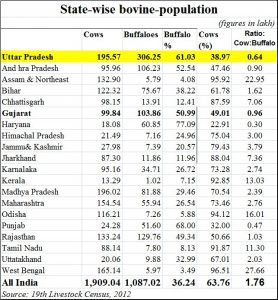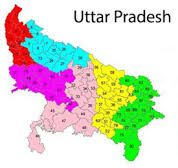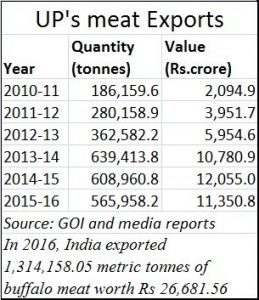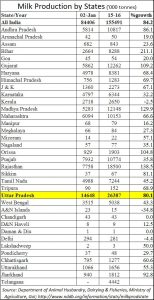http://www.firstpost.com/business/ups-job-woes-cm-yogi-adityanaths-slaughterhouse-ban-could-see-painfull-days-ahead-3347442.html
UP’s Yogi Adityanath could transform Uttar Pradesh – but not the way to prosperity
By RN Bhaskar
Yogi Adityanath, the new chief minister of Uttar Pradesh — India’s most populous state, inherits a legacy that could drive the state into greater poverty. And his recent announcements haven’t helped either.
He assumes charge of a government which has already promised a loan waiver in its election manifesto. If this is to be implemented, expect the banks to be hit with another Rs 27,420 crore of bad debt which will have to be written off. Significantly, the Union government refused to talk about it in the Parliament on Monday, 20 August.
Then there is this unfortunate statement that Yogi Adityanath made immediately after taking over as the CM. He announced that all illegal slaughterhouses would be closed down. There is no mention of how existing legal abattoirs would augment intake and thus compensate for the lost capacity.
 That could adversely affect UP’s meat exports of Rs 11,351 crore (2015-16 figures).
That could adversely affect UP’s meat exports of Rs 11,351 crore (2015-16 figures).
The cow is an endangered species in UP
The fact is that he is known to be a strident critic of cow slaughter – something that the party at the Centre is also committed to. Given this background, and his recent pronouncements, he could well make the cow an endangered species in UP itself. It is worth remembering that UP is already the biggest milk producing state in India.
But it cannot take this position for granted. There are indications that milk production in other states has been growing faster than in UP. And the combined whammy of a ban on illegal slaughterhouses on the one hand, and the strident campaign against cow slaughter on the other could adversely affect milk production as well.
 Just watch the way people have begun shunning the ownership of cows. Look at the ratio of cows to buffaloes. One would have thought that the cow belt would have seen more cows than buffaloes. Instead, UP sports a ratio of just 0.64, The only other states to sport lower ratios are Harayana (0.3) and Punjab (0.47).
Just watch the way people have begun shunning the ownership of cows. Look at the ratio of cows to buffaloes. One would have thought that the cow belt would have seen more cows than buffaloes. Instead, UP sports a ratio of just 0.64, The only other states to sport lower ratios are Harayana (0.3) and Punjab (0.47).
Look for states where the ratio of cows is high. Here you have West Bengal at 27, Assam at Odisha at 16, and Kerala at 13.
What is common to all these states? None of them want to pursue the ban on cow slaughter. Hence, the population of cows has flourished. If the cries against cow slaughter become any more strident in UP, the cow could well be declared an endangered species there.
The slaughter of jobs
Take another problem. UP is already the largest meat exporting state in India, accounting for annual export turnover of Rs 11,351 crore (India’s total meat exports were worth Rs 26,682 crore). By banning slaughter houses, the chief minister could well cause three major upheavals in the state.
First, it will affect a bulk of India’s meat exports.
 Second, it will render thousands (if not millions) of people unemployed.
Second, it will render thousands (if not millions) of people unemployed.
Third, it will affect the leather industry, which is one of the biggest exporting industries in India.
Ideally, the chief minister should have announced that illegal units should get regularised by following a set of conditions. Or he should have enhanced the capacities of existing (legal) slaughterhouses. He chose to do neither.
Thus India will see a slaughter of jobs as well. For a country that has been begging for an increase in job creation, the past six months will be witness to two moves, both which have caused job destruction. One was demonetisation. The other could be the ban on meat slaughter. This is no way to “making UP Uttam Pradesh”.
As things stand, UP accounts for 38 (of the 62 government approved) slaughter houses in India of which 37 produce and export buffalo meat. But that is also because UP’s share in the meat market is not to be sniffed at.
 According to the 19th Livestock Census of 2012, but tabled in 2014, the Animal Husbandry, Dairying and Fisheries department shows UP contributing to 19.1 percent. This was followed by Andhra Pradesh ( (15.2 percent) and West Bengal (10.9 percent).
According to the 19th Livestock Census of 2012, but tabled in 2014, the Animal Husbandry, Dairying and Fisheries department shows UP contributing to 19.1 percent. This was followed by Andhra Pradesh ( (15.2 percent) and West Bengal (10.9 percent).
The ban on slaughter could actually drive North India’s cattle slaughter to West Bengal (with adverse political consequences for the ruling party at the Centre). In South India, the slaughter industry is likely to remain with Andhra Pradesh which also boasts of a very large leather industry.
 But the danger for UP is the sudden loss of jobs – and with no new industries emerging to replace the lost income sources. Worse still, it could also adversely affect milk production, as farmers suddenly find the price of aged cattle falling, because they cannot be easily sent for slaughter.
But the danger for UP is the sudden loss of jobs – and with no new industries emerging to replace the lost income sources. Worse still, it could also adversely affect milk production, as farmers suddenly find the price of aged cattle falling, because they cannot be easily sent for slaughter.
Will milk production also shrink?
But there is a much bigger problem that could befall UP. The present policies of the government could diminish UP’s role of being the largest milk producer in India. To understand this, watch the table of milk production by states.
Watch how the growth of milk production in UP (since 2002) has been lower than the all India average of 84 percent. Compare this with 138 percent for Rajasthan and 104 percent for Orissa. Even compare this with Gujarat where the growth has been 109 percent.
 Clearly, despite being the birth place of Lord Krishna, and one which has always celebrated cows, nobody wants to look after cows any more. If this continues, UP could slip a few notches further.
Clearly, despite being the birth place of Lord Krishna, and one which has always celebrated cows, nobody wants to look after cows any more. If this continues, UP could slip a few notches further.
Already, UP is not the most prosperous of states. It is close to the bottom of poor Indian states, than to the top. By destroying jobs, and eroding wealth generating industries, without an alternative solution, UP could see very painful days ahead.











































COMMENTS